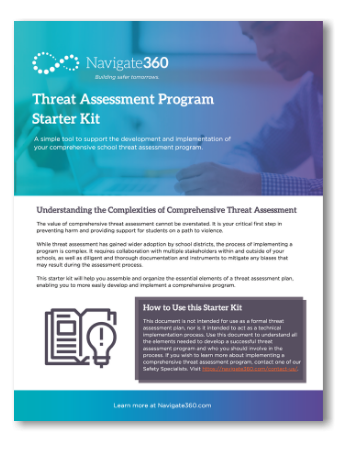The Need for Effective Threat Detection & Violence Prevention for Schools
Did you know more than 3,000 threats were made against K-12 schools in the 2018-19 school year, and over 3,700 suicide attempts occur each day among kids in grades 9-12?
Uncertainty, isolation and a variety of additional social stressors are resulting in increased depression and anxiety for students in your care. Furthermore, disrupted learning is disconnecting your community now more than ever before. Left unchecked, this disconnection can pose serious risks for your schools, weakening confidence and exacerbating safety vulnerabilities within your learning environments.
School districts across the nation are increasingly adopting threat detection and violence prevention programs. However, implementation is complicated and requires strong collaboration with stakeholders both in and outside of your schools.
As a trusted leader in school safety, Navigate360 offers expert resources to help your team fully understand the critical steps involved in implementation and strategies to make the programs as impactful as they can be. See how we can help your school create a safe and productive learning environment in which everyone can thrive.
- Learn How to Begin Building Your Threat Detection & Prevention Program
- Discover The Differences Between Various Threat Assessment Models
- Learn How to Collect Information from Your Community
- Learn How to Help Students Who Display Issues
- Get Access to Additional Threat Detection & Prevention Resources for Schools

Begin Building Your Threat Assessment Program & Team With Our Starter Kit
Build Your School Threat Detection & Violence Prevention Program
Comprehensive threat detection and school violence prevention programs build a strong culture of safety by:
- Establishing and communicating standards for threatening behaviors;
- Providing safe ways for individuals to report concerns;
- Creating dedicated threat assessment teams to manage cases; and
- Reinforcing the value of physical, social and emotional safety for your staff, students and caregivers.
Your school can build this culture of safety with tools that are adaptable to both in-person and remote learning environments. See how you can implement these program elements and begin to steer students onto a safer path.
Building A Diverse Team of Experts
Threats and concerning behaviors take many different forms. A diverse threat detection and assessment team allows you to evaluate threats from multiple viewpoints, mitigating bias and ensuring concerns are managed mindfully. Your threat assessment team is the foundation for your violence prevention program and should include, at a minimum, the following:
- School resource officers or local law enforcement
- School psychologists/counselors/mental health professionals
- Emergency or safety managers
- School administrators, including principals
Defining Threats and Behaviors
The year 2020 has shown us that threats can come in many different forms, and they require thoughtful definition for effective identification. Use your team of experts to define threatening behavior and establish processes for reporting such behavior. Use plain language to outline your team’s path for intervention and resolution.
While definitions are an important part of the process, your team must also understand that there is NO profile for a student who causes harm. The use of profiling is counterintuitive to the threat detection and assessment process, and it increases the likelihood of misidentifying those students who pose a risk.
Making Community Aware
Once you have defined what a threat is and the procedures required for successful threat management, your team should work with your district to validate, solidify and publish policy updates.
Work with your threat assessment team to publicize policies that communicate the following:
- Why the policy updates were made
- Who crafted the policies and who to contact with questions
- Where and how stakeholders can access the policies
- How the new policies will impact existing procedures
The announcement policy updates provide your district with more transparency and shows your community that school safety is a priority.

Find strategies to update and communicate these new school policies in our Complete Guide to Effective Threat Detection & Violence Prevention for Schools.
Threat Assessment Models
Once you build a team and define behaviors, choose a threat assessment model for team members to use to evaluate all of the collected information. Consider these different models to help your team fully assess, document and create a path to resolution for any threat quickly and efficiently.
National Threat Assessment Center (NTAC)
The National Threat Assessment Center (NTAC) was established in 1998 to conduct research on acts of targeted violence and provide guidance and training on threat assessment to communities and organizations throughout the country. NTAC’s July 2018 manual offers a reputable methodology that can guide your team through screening cases, gathering information and analyzing resulting data. NTAC uses U.S. Secret Service guidelines for threat assessment, including 11 questions that aim to identify, investigate and manage individuals of concern.
Comprehensive Student Threat Assessment Guidelines (CSTAG)
Comprehensive School Threat Assessment Guidelines (CSTAG) was developed by Dr. Dewey Cornell at the University of Virginia through years of research in schools. The model provides a research-supported decision tree style process to ensure student mental health is assessed and addressed before any action is taken. The model is prescriptive throughout to reach a resolution quickly. With a focus on helping students in distress and putting them on the correct path, the CSTAG approach has been shown to reduce suspensions and improve students’ overall wellbeing at school.
Salem-Keizer Threat Assessment System
The Salem-Keizer threat assessment model is part of a multi-agency threat assessment structure and was developed nearly 20 years ago for the Salem-Keizer public school system in Salem, Oregon. A unique collaborative team of schools, law enforcement, public mental health, the judiciary and juvenile corrections oversees assessment protocols and safety planning procedures to provide an immediate and systematic response to youth who pose a serious threat to commit violence to others. The two-level system maximizes resources using different perspectives: a school site-based multi-disciplinary team (level 1) and a multi-agency community team (level 2). One survey found that more than 94% of administrators reported that the model effectively identified potentially dangerous students and situations, had positive effects on school safety and fulfilled a valuable role in schools.
What Signs to Look for in a Troubled Student
Four out of five students who have attempted suicide showed obvious signs. We cannot overstate the importance of teachers and staff understanding the signs of harmful intention or behavior. Knowing the warning signs and recognizing troubled students could help prevent violence toward themselves and/or others.
- Withdrawing from social contact
- Increasing the use of alcohol or drugs
- Having been a victim of violence
- Having mood swings
- Showing poor academic performance
- Feeling trapped or hopeless about a situation
- Talking or writing about suicide
- Changing routine, including eating or sleeping patterns
- Doing risky or self-destructive things
Collecting Information Concerning Students Behavior or Violence
According to the Navigate360 / Zogby Strategies Public Safety and Security Survey, only 36% of teens ages 16-17 know who to contact to report a threat, and less than half (42%) believe their school is doing its best to create an atmosphere of physical and emotional safety.
Effective threat assessment relies on the ability of all teachers, faculty and students knowing where and how to report potential concerns. Collecting reliable information will be one of the greatest challenges you face when implementing your program. Current statistics surrounding school violence suggest that most behaviors or threats are identified but never reported. This is because individuals fear repercussions from those they report.
Tools like our P3 Campus: Anonymous Tip Reporting can help to mitigate this fear and encourage people to report concerning behavior. P3 equips students, staff and community members to report tips about a student’s concerning behavior via a mobile app, web-based platform or telephone hotline 24 hours a day.
While anonymous tip reporting builds trust and allows individuals to safely report concerns, your team should consider additional proactive tools that monitor and identify threats ethically and accurately.
With millions of online conversations happening through social media and e-mail, countless pieces of information could slip through the cracks. Social media scanning and e-mail sentiment analysis provide you with an additional layer of valuable information that could save lives.
Once you find the methods that best serve your staff to most effectively collect information, be sure to inform your community of these tools and educate them on their value. Explain what information is collected and how it’s used to keep your school community safe.
See How Comprehensive Threat Detection & Prevention Solutions Improve Safety for Your Staff & Students
How to Help Students Who Display Issues
Your team has a substantial program in place for threat identification and management, and staff has been trained on your chosen threat assessment model and related processes. Once you identify a viable threat, the team must work with parents, the administration and others to steer students onto a safer path through intervention. Focus your intervention efforts on providing support, not just punishment.
Social-emotional Learning (SEL)
Social-emotional learning (SEL) is a proactive way for your school to improve school climate ratings, decrease behavioral problems and build confidence in your students. The five core components of SEL are:
- Self-awareness
- Self-management
- Responsible decision making
- Relationship Skills
- Social Awareness
While the goal of SEL is to prevent problems before they start, it can also turn discipline into a valuable learning opportunity. Depending on the concerning behavior or infraction, your team can provide students in crisis with tailored learning experiences that help them understand their own value within your school community as they build empathy for others and work to understand the impact of their actions.
Research has shown that students are more likely to develop positive attitudes toward authority and to the concept of fairness through SEL programs.
Communication with Others
SEL provides caregivers (parents, guardians and school staff) with accessible resources to reinforce the concepts relayed to students with behavior problems. Training your entire community (not just the students) on these concepts establishes consistency and highlights your commitment to building an inclusive and transparent culture of safety.
Other Interventions
If the student broke the law or violated the district’s conduct code, specific punishment may be required. However, punishment without supportive intervention can cause more or unnecessary harm to the student. Instead, prioritize collaborative intervention between the school, community agencies, parents and students themselves, as these more often lead to positive long-term outcomes.
Collaborative options include mentoring programs or mental health counseling services can help the student process through their feelings (and possibly recognize that other people care about their story). Problem-focused and action-oriented behavioral therapies also can be useful in confronting anger, stress and other psychological concerns.
Other Tools
We encourage you to use this free Behavioral Threat Assessment eBook Series to begin building your program. This series of three eBooks details how you can leverage the power of behavioral threat assessment to prevent violence in your school. Topics include:
- Creating and Training School Behavioral Threat Assessment Teams
- Gathering and Evaluating Information for Behavioral Threat Assessments
- Creating a Centralized Reporting System and Exploring the Legal Considerations of Behavioral Threat Assessment
These additional tools may be helpful in understanding more about threat assessment and violence prevention in schools:
- [SOLUTION] Behavioral Threat Assessment Case Manager
- [GUIDE] Threat Assessment Starter Kit
- [GUIDE] Best Practice Considerations for K–12 Schools
- [RESOURCE] Behavioral Threat Assessment in the Virtual Environment
- [SOLUTION] CSTAG Threat Assessment Training
- [WEBINAR] Emerging Issues in School Threat Assessment
- [RESOURCE] Family Educational Rights and Privacy Act (FERPA)
Navigate360 Threat Detection & Prevention Solutions for Schools
Build your program with help from the school threat detection & prevention experts.
Download the guide now or schedule a safety consultation to learn more about our school threat detection and violence prevention solutions.
or call us at 330-661-0106.
